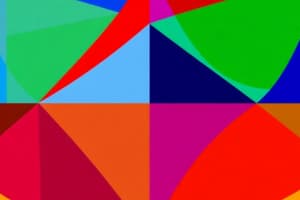Podcast
Questions and Answers
What is a parallelogram?
What is a parallelogram?
- A quadrilateral with no parallel sides
- A quadrilateral with only one pair of opposite sides that are parallel
- A quadrilateral with all sides equal
- A quadrilateral with two pairs of opposite sides that are parallel (correct)
What are the properties of a rectangle?
What are the properties of a rectangle?
It has all right angles, congruent diagonals, and five properties of parallelograms.
A rhombus is a parallelogram in which at least two consecutive sides are ______.
A rhombus is a parallelogram in which at least two consecutive sides are ______.
congruent
All properties of a rectangle also apply to a square.
All properties of a rectangle also apply to a square.
Which of the following is true about a kite?
Which of the following is true about a kite?
What defines a trapezoid?
What defines a trapezoid?
Which statement is true about isosceles trapezoids?
Which statement is true about isosceles trapezoids?
Match the following quadrilaterals with their definitions:
Match the following quadrilaterals with their definitions:
Flashcards are hidden until you start studying
Study Notes
Parallelogram
- A quadrilateral where both pairs of opposite sides are parallel.
- Opposite sides are congruent, ensuring equal length.
- Opposite angles are congruent, providing equal angular measures.
- Diagonals bisect each other, indicating they split into equal parts at their intersection.
- Consecutive angles are supplementary, meaning each pair sums up to 180 degrees.
Rectangle
- A specific type of parallelogram with at least one right angle.
- Inherits all properties of parallelograms, ensuring opposite sides are parallel and congruent.
- All angles are right angles, establishing a 90-degree measure for each corner.
- Diagonals of a rectangle are congruent, meaning they are equal in length.
Rhombus
- A unique parallelogram where at least two consecutive sides are congruent.
- All sides are congruent, making it equilateral.
- The diagonals bisect each angle, dividing the angles into two equal parts.
- Diagonals are perpendicular, intersecting at right angles.
- Diagonals divide the quadrilateral into four congruent right triangles.
Square
- A quadrilateral that fulfills the properties of both a rectangle and a rhombus.
- Contains all properties of parallelograms, ensuring parallelism and congruence.
- Mirrors all properties of rectangles, including right angles and congruent diagonals.
- Exhibits all characteristics of a rhombus, including equal side lengths and perpendicular diagonals.
Kite
- A quadrilateral with two distinct pairs of consecutive sides that are congruent.
- Diagonals intersect at right angles, creating additional symmetrical properties.
- One diagonal acts as the perpendicular bisector of the other, ensuring symmetry.
- One diagonal bisects a pair of opposite angles, leading to equal angular measures in those angles.
- One pair of opposite angles are congruent, adding to the overall symmetry.
Trapezoid
- A quadrilateral characterized by one pair of parallel sides, referred to as the bases.
- Non-parallel sides are defined as legs, creating distinction between sides.
- The bases maintain parallelism, impacting the trapezoid's angles and properties.
Isosceles Trapezoid
- A specific trapezoid where the non-parallel sides (legs) are congruent.
- Bases remain parallel, preserving key trapezoidal characteristics.
- Lower and upper base angles are congruent, ensuring symmetry in angular measurements.
- Diagonals are congruent, indicating equal lengths between the two diagonals.
- Each lower base angle is supplementary to the corresponding upper base angle, summing to 180 degrees.
Studying That Suits You
Use AI to generate personalized quizzes and flashcards to suit your learning preferences.




